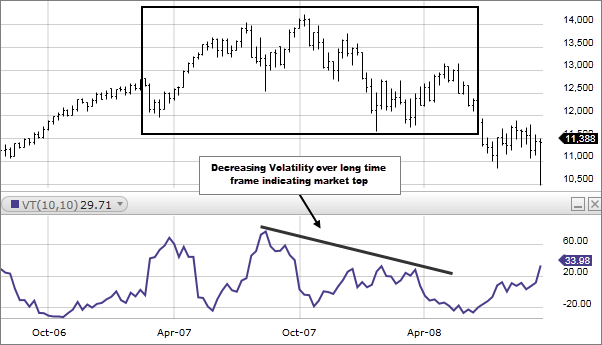
Options traders need to factor in various parameters before deciding on which strategy to implement, the price at which to enter the market and the potential outcomes of a trade. One of the most crucial parameters in this context is the implied volatility (IV). In this article, we delve into what this parameter means, how it is evaluated and which strategies you can use in scenarios with high IV and low IV.
What is Implied Volatility (IV)?
Implied volatility (IV) is a measure of how the market expects the price of an underlying asset to change in the future. In other words, it is the expected volatility in the underlying asset’s price. This metric is important in options pricing techniques like the Black-Scholes Model, which uses five key inputs to compute the value of an options contract — namely, the risk-free interest rate, the volatility, the underlying asset’s price, the time left till expiry and the option’s strike price.
High IV results in high options premiums because of the increased likelihood of the derivative becoming profitable (i.e. becoming in-the-money or ITM). Conversely, low IV in the underlying asset leads to low options premiums because the chances of the derivative becoming an ITM contract are reduced.
Since implied volatility plays a crucial role in how options are priced, they must be accounted for when you are choosing options trading strategies. Here is where metrics like the IV percentile and IV rank can help.
IV Percentile: Meaning and Computation
Implied volatility percentile (IVP) measures the number/percentage of days within a predefined look-back period during which the underlying asset’s IV was below its current IV. For instance, say you take a look-back period of 100 days for an underlying asset whose current IV is 45%. If the underlying asset’s IVP for this predefined period is 10%, it means that the asset’s IV was below 45% on 10 out of those 100 days.
The formula to compute the IVP is as follows:
Implied Volatility Percentile = (Number of Days When the IV Was Lower than Current IV) ÷ (Number of Days in the Look-Back Period) x 100
For example, say the current IV of the underlying asset is 35%. If its IV was below this level on 60 out of 250 days, the asset’s IVP over the 250-day period can be computed as follows:
Implied Volatility Percentile:
= (Number of Days When the IV Was Lower than Current IV) ÷ (Number of Days in the Look-Back Period) x 100
= (60 ÷ 250) x 100
= 24%
Interpreting the IV Percentile
A low IVP means that the implied volatility was above the current IV level for most of the days over the look-back period. Conversely, a high IVP indicates that for the vast majority of the look-back period, the underlying asset’s IV was lower than its current IV. Knowing the historical IV levels of an asset can help you anticipate future volatility.
Take the above example, for instance. The IVP is 24%, which means the implied volatility of the underlying asset was below the current IV of 35% on 24% of the past 250 days. It also implies the following:
- Relatively Low Current IV: The current IV of 35% is relatively low compared to its levels over the past 250 days. Specifically, the IV was higher than 35% on 76% of the days, indicating that the current IV is below its usual levels.
- Potential Options Pricing: Since the IVP is relatively low (24%), it suggests that options may be less expensive now than they have been historically. This is because lower IV generally leads to lower options premiums.
- Market Expectations: The lower current IV suggests that the market is expecting less significant price movements in the underlying asset compared to its recent past. This could be due to a lack of upcoming events, earnings reports, or other factors that might influence the asset’s price volatility.
IV Rank: Meaning and Computation
Implied volatility rank (IVR) measures how the current IV of the underlying stock or security compares to its IV over a predefined or designated period. For instance, if you take the predefined look-back period as 52 weeks, the IVR measures the IV current trading session on a scale of 0 to 100. Here, 0 represents the lowest IV% during the 52 weeks, while 100 represents the highest IV% during the same period.
The formula to compute the IVR is as follows:
Implied Volatility Rank = (Current IV — Minimum IV in the Look-Back Period) ÷ (Maximum IV in the Look-Back Period — Minimum IV in the Look-Back Period)
For example, say a stock’s IV ranged from 20% to 75% in the last 52 weeks. If the stock’s current IV is 40%, its IV rank can be computed as shown below.
Implied Volatility Rank:
= (Current IV — Minimum IV in the Look-Back Period) ÷ (Maximum IV in the Look-Back Period — Minimum IV in the Look-Back Period)
= (40% — 20%) ÷ (75% — 20%)
= 20% ÷ 55%
= 0.3636 or 36.36%
Interpreting the IV Rank
The closer the IVR is to 100, the closer the current IV in the underlying asset is to the higher end of the range. This indicates a high level of implied volatility and is a sign that the options based on the underlying asset may be more expensive. If the IVR is closer to 0, the opposite is true. Additionally, as the IVR increases, options start to get costlier.
For instance, in the above example, we have an IVR of 36.36%. Here is how this metric can be interpreted practically.
- Low Volatility: The stock’s current IV is in the lower part of its historical range. This suggests that the market does not expect significant price movements in the near term.
- Potential Opportunity for Buyers: If you believe that the stock’s IV will increase by expiry, buying options could be more attractive because they are now relatively cheaper — since the IV is low.
- Caution for Sellers: Selling options might be less attractive since it could mean that you receive less premium now, when the IV is low, thus reducing potential profits.
If you expect a further decline in the IV by expiry, the converse will be true.
Options Trading Strategies for High IV Markets
In high implied volatility (IV) markets, options premiums are higher because the market expects larger price swings. If the IV is currently high and you expect it to decrease over the short term, strategies that involve writing options may be suitable because they allow you to sell options before they lose value.
Here are some options trading strategies that are suited to high (and potentially decreasing) IV market conditions.
- Covered Call: This options trading strategy involves holding the underlying stock and selling call options on it. The high premiums received from selling calls provide income and can offset potential drops in the stock price.
- Iron Condor: This strategy involves selling a call spread and a put spread at different strike prices but with the same expiry. The goal is to profit from the premiums collected, assuming the stock price remains within a certain range. The high IV means higher premiums, which increase the potential profits.
- Selling Strangles and Straddles: Selling strangles (selling out-of-the-money call and put options) or straddles (selling at-the-money call and put options) can be suitable for high IV environments. The risk is that large price movements can lead to significant losses, so these options trading strategies are best for traders expecting IV to decrease.
Options Trading Strategies for Low IV Markets
In low implied volatility (IV) markets, options premiums are lower because the market expects smaller price swings. In case the IV is currently low and you anticipate a rise in the implied volatility over the short term, you could consider strategies that involve buying options because you can purchase options that may rise in value.
Check out some options trading strategies that work well in low (and potentially increasing) IV conditions.
- Buying Straddles and Strangles: In low IV markets, buying straddles (both call and put at the same strike price) or strangles (out-of-the-money call and put options) can be effective. These options trading strategies have the potential to profit from significant moves in either direction and potential increases in IV.
- Vertical Spreads: Both bull call spreads (buying a call and selling a higher strike call) and bear put spreads (buying a put and selling a lower strike put) can be used to limit your risk while taking advantage of potential directional moves. These options trading strategies are cost-effective in low IV environments because of the lower premiums involved.
- Calendar Spreads: This options trading strategy involves buying a longer-term option and selling a shorter-term option at the same strike price. It could also be potentially profitable because of the profits from the time decay of the short-term option and the increase in IV of the long-term option.
Conclusion
The bottom line is that before implementing an options trading strategy, you need to assess the IV, IVR and IVP and factor in how the options premium could change between initiating the trade and options expiry. If you have any doubts about integrating IV into your trading decisions or if you need help from other expert traders and analysts, the Samco forum is the place to be. This is an online community for traders to share their insights and learn from one another’s experiences.
The Samco forum is not the only benefit of becoming a Samco customer. If you sign up for a demat and trading account with Samco Securities, you can also access the Samco trading app, which has a wide range of features specifically designed to make options trading easy.
They include real-time access to market data, updated insights about options Greeks and implied volatility and hidden insights (or Andekha Sach) about what works and what doesn’t based on your past trades. Furthermore, the Samco trading app also gives you Options B.R.O, Samco’s proprietary options strategy builder. The best part? All these features and more are available free of cost to Samco users.





